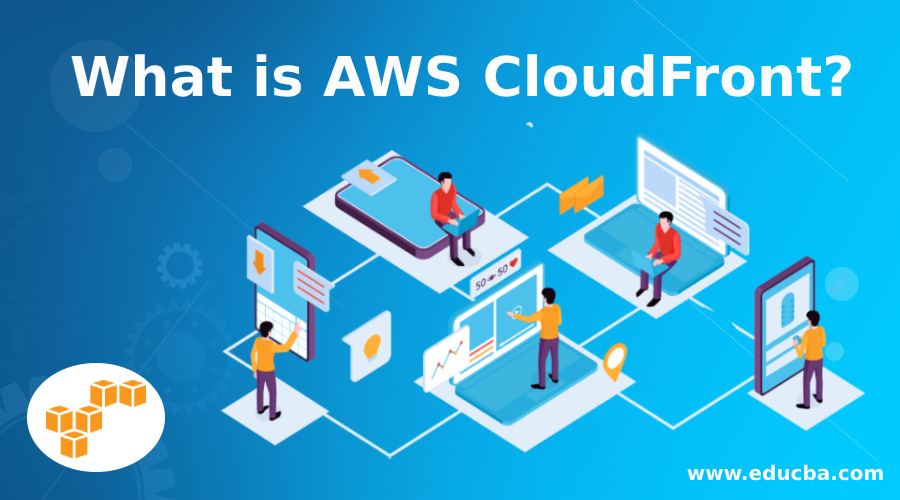Updated June 8, 2023
Introduction To AWS CloudFront
AWS Cloudfront is one of the leading content delivery network services or CDN. CloudFront is a popular web content management and distribution service with scalable features. It processes and distributes static and dynamic web content and video and application files with low latency and high transfer rates. In addition, AWS Cloud Front distributes the content that is sourced from the Amazon S3 bucket store through regional centers known as edge locations.
The CloudFront service supports caching for faster web content delivery based on the content available on the CloudFront edge locations. Several case studies are available for implementing services specific to the media and entertainment industry. Some popular AWS CloudFront applications are Amazon Prime Videos, Spotify, Hulu, and Sky News. It is also widely used for software distribution lifecycles.
How to Configure CloudFront to Deliver Content?
A CloudFront distribution needs to be created, which tells the CloudFront from where your content would be delivered and other details like how to manage content delivery etc.
- Origin servers, such as the Amazon S3 bucket, must be specified. CloudFront accesses your files from these servers and then distributes them globally through CloudFront edge locations.
- After specifying the origin servers, upload your files to these origin servers. Files uploaded are called objects, and they can be web pages, media files, or others that can be served over HTTP.
- Then create a CloudFront distribution that would tell the CloudFront from which origin server it needs to access your files when users request them.
- Then CloudFront assigns a domain name to your newly created distribution, which would be visible in the CloudFront console.
- CloudFront sends your distribution configuration to all its edge locations, where CloudFront caches copies of your objects.
How is Content Delivered to Users by CloudFront?
After configuring CloudFront, user’s requests are handled as follows:
- Users can access your application or website and request required objects, like an HTML or media file.
- When the user sends a request, Domain Name Server (DNS) sends or routes the request to the nearest CloudFront edge location or an edge location that best serves it.
- There can be two possibilities at the edge location, i.e., whether the files requested are in the cache or not. If files are in the cache then CloudFront returns them to the user, and if files are not present in the cache, then:
- CloudFront compares the specifications in your distribution with the request. Then forwards the request to the origin server of your distribution, like the Amazon S3 bucket, for accessing the requested files.
- The origin server sends the requested files to the CloudFront edge location.
- When the requested files’ first byte arrives, CloudFront sends the files to the user.
- It also saves the files to the cache of CloudFront edge location so that they can be accessed easily in the future if the same or another user requests them.
Advantages of AWS CloudFront
Below are mentioned the advantages :
- Fast and time-saving
- Can distribute data globally
- Highly secure content delivery network.
- Highly programmable
- Integration with Amazon Web Services (AWS) that is extensive or thorough
- Provides SSL optimizations and advanced capabilities like Field-Level Encryption, Session tickets, TLS Protocol Enforcements, etc.
- Provides Access control.
- Enables redundancy for origins
- Optimal performance due to network optimizations.
- Availability of many tools such as CodeCommit, CodeDeploy, etc.
- Pay-as-you-go feature, i.e., cost-effective
- Free transfer of data between Amazon CloudFront and AWS cloud services.
- Integrating network
- Geo-targeting
- Removes invalid files
AWS CloudFront Case Studies
- Hulu
- Amazon Prime Video
- Sky News
- M6
- Blue Billywig
- TVNZ
- Discovery Communications
- Spotify
- Bambuser
- Seven Networks
- Haystack TV
- Outkast
- NASA
- Spuul
- King Digital Entertainment PLC
- Supercell
- CCP Games
- Lockwood Publishing
- MovieStar Planet
- Instacart
- Amazon Fresh
- Vivino
- Digital Foodie
- TicketLeap
- Slack
- Nextdoor
- com
- Tozny
- my6sense
- Desire2Learn
- Canon
- Mapbox
- Dexecure
Use Cases of CloudFront
- Static Asset Caching
- Security
- Live and On-Demand Video Streaming
- Dynamic content
- API Acceleration
- Customizable content delivery using Lambda@Edge
- Software distribution
Scope
Amazon CloudFront is the fastest-growing service in all Amazon Web Services. It’s low latency and highest throughput made it popular among companies who need rapid transferring of their content. Because it offers security throughout data transportation, it is reliable. It is one of the most innovative, progressive, and innovative technology. It would help a lot in career growth.
Who is the Right Audience for Learning AWS CloudFront Technologies?
Anyone can learn these technologies, but it will be easy if you have prior knowledge about some topics like:
- Knowledge of Operating Systems
- Knowledge of virtualization
- understanding of networking
- Knowledge of software engineering tools
- Datacenter facilities
How will this technology Help you in Career Growth?
This technology is fast growing and is very popular among renowned companies. There are multiple job opportunities across the globe in the field of AWS CloudFront. The salary of a Software engineer ranges from $83,000 to $124,000, and the salary of a Senior Software Developer ranges from $151,000 to $217,000.
Conclusion
This article gives you a brief about what is AWS CloudFront. This is an innovative, dynamic, and exciting area to pursue your career. Thousands of job opportunities are available across the globe for people interested.
Recommended Articles
This has been a guide to What is AWS CloudFront. Here we discussed the concept, scope, use, advantages, case studies, and career in AWS CloudFront. You can also go through our other Suggested Articles to learn more –




